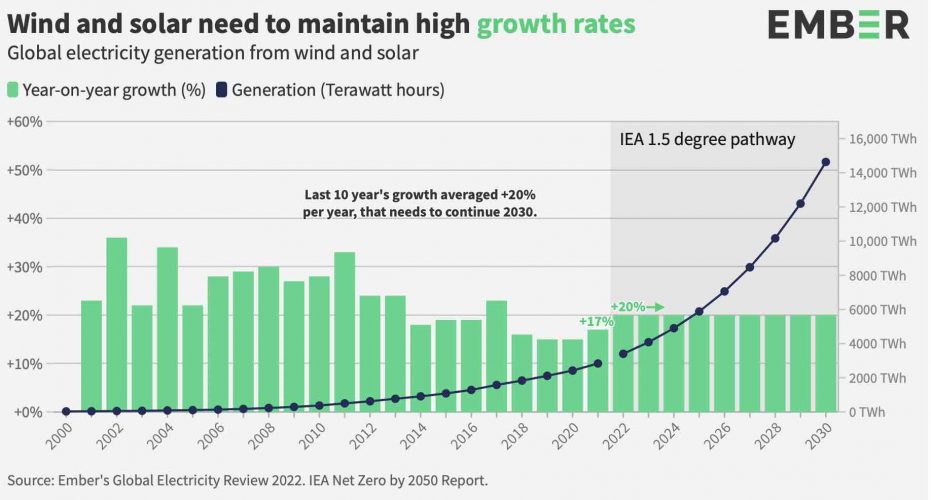The share of wind and solar in the world’s electricity production has exceeded 10 per cent for the first time, as China and Japan joined some 50 different countries to exceed that level in 2021.
The new assessment, from the UK-based Ember, notes that wind and solar are the fastest growing sources of electricity, and if maintained at current rates could deliver enough capacity to help cap average global warming at around 1.5°C.
The problem is that in the past year, fossil fuel production and emissions have also jumped after a Covid-caused hiatus, and more coal is being burned because gas has become too expensive.
“Wind and solar have arrived,” says David Jones, the lead author of Ember’s third annual Global Electricity Review. “The process that will reshape the existing energy system has begun.”

Jones says solar generation rose 23 per cent last year, and wind by 14 per cent, taking the combined output to 10.3 per cent of global electricity generation, up from 9.3 per cent a year earlier, and double the 4.6 per cent in 2015, when the Paris climate treaty was agreed.
All clean electricity sources – including nuclear (10.1 per cent) and hydro (15.3 per cent) – generated 38 per cent of the world’s electricity in 2021, which was more than coal (36 per cent) despite that commodity’s biggest annual jump since 1985 to a new record high.
“To be on a pathway that keeps global heating to 1.5 degrees, wind and solar need to sustain high compound growth rates of 20% every year to 2030. That’s the same rate of growth as their average over the last decade,” Jones says.
“This is now eminently possible: wind and solar are the lowest cost source of electricity on a levelised basis, with ever-increasing global experience of integrating them into grids at high levels.
“With 50 individual countries now generating more than 10% of their electricity from these quick-to-deploy resources, and three countries already generating over 40%, it is already clear that these technologies are delivering.”
Jones notes that governments such as the US, Germany, UK and Canada are so confident in clean electricity that they are planning to shift their grid to 100% clean electricity within the next decade and a half.
“But with coal still rising and electricity demand continuing to increase, all governments with carbon intensive grids now need to act with that same boldness and ambition.”
The countries leading the shift to wind and solar are Denmark, Uruguay and Luxembourg, which delivered shares of 52 per cent, 47 per cent and 43 per cent respectively.
Australia figures relatively high with a share of more than 22 per cent. It also highlights the extraordinary achievements in South Australia, which in 2021 reached 62 per cent share of wind and solar.
Australia also gets an honourable mention for being one of three countries – along with the Netherlands and Viet Nam – that have shifted more than 8 per cent of their total electricity demand from fossil fuels to wind and solar in just the last two years.
Which is not bad for a country’s whose federal government has done all it can to actually stop that transition, and whose energy minister has often and loudly protested there is too much wind and solar in the grid.
In fact, Australia’s world-leading efforts on solar are highlighted in the table below below, showing how much it has added to the local grid, in percentage terms, since 2015. The data includes rooftop solar.
The countries to reach a 10 per cent wind and solar share of their local grids in the past year include China, Japan, Mongolia, Viet Nam, Argentina, Hungary and El Salvador.
“Even as coal and power emissions hit another all-time high, there are clear signs that the global electricity transition is well underway,” Jones says.
“More wind and solar is being added to grids than ever. And not just in a few countries, but across the world. They are able—and expected—to provide the majority of clean electricity needed to phase out all fossil fuels, at the same time helping to increase energy security.
“But with sustained high gas prices amid Russia’s war with Ukraine, there is a real risk of relapse into coal, threatening the global 1.5 degrees climate goal.
“Clean electricity now needs to be built on a heroic scale. Leaders are only just waking up to the challenge of how quickly they need to move to 100% clean electricity.”












